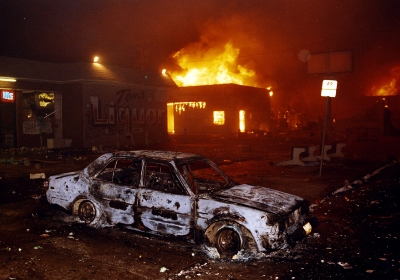Apr 27 2012
Eye Witness Account of LA Uprising, 20 Years Ago
 In the early hours of March 3, 1991, Rodney King, then 25 years old, was driving with two passengers when LAPD officers attempted to pull him over for speeding. Instead of stopping, King attempted to evade the police, resulting in a high speed chase for about 8 miles over freeways and onto residential streets before he came to a stop. A neighborhood resident with a video camera filmed much of what followed, and images of Rodney King, a black man, being beaten by cops, would be replayed on the news countless times in the following months.
In the early hours of March 3, 1991, Rodney King, then 25 years old, was driving with two passengers when LAPD officers attempted to pull him over for speeding. Instead of stopping, King attempted to evade the police, resulting in a high speed chase for about 8 miles over freeways and onto residential streets before he came to a stop. A neighborhood resident with a video camera filmed much of what followed, and images of Rodney King, a black man, being beaten by cops, would be replayed on the news countless times in the following months.
The beating ignited a firestorm of debate about police brutality and race in Los Angeles. Communities of color, especially black residents, had long charged that police brutality was commonplace, but ignored by the city. The nearly all white jury that eventually acquitted 3 officers on all charges on April 29th, 1992, believed King resisted arrest and that the police had acted reasonably to subdue him.
LA community leaders anticipated that an acquittal would enrage the city’s black and brown residents, many of whom not only suffered from an aggressively violent police department but also from poverty in a city with extreme wealth inequality. Racial tensions between communities were also running high. Just weeks after the Rodney King beating, a female Korean store owner, Soon Ja Du in South LA shot and killed a young black teenage girl Latasha Harlin, who she believed was stealing orange juice. The store owner did not serve jail time for the shooting, and anger over the incident simmered throughout the communities.
On April 29th 1992, as shock and outrage at the Rodney King verdict was expressed across LA, some 150 volunteers, largely from African American church and community groups, were dispatched to urge residents to remain non-violent. Reverend Cecil Murray, former pastor of the First African Methodist Church, told the Huffington Post that history may have been different if police had supported their efforts. However the LAPD was seemingly not prepared with a city-wide response. Then Police Chief Daryl Gates was later blamed for failing to issue a tactical alert once the verdict was read. On the first night of unrest, Gates appeared nonplussed and attended a fundraising dinner.
The violence accompanying the LA Uprising continued for days before calm was restored. Ultimately, over 60 people were killed and 2,300 injured as a result of the unrest, and over 1000 buildings were damaged or destroyed. Calls for reconciliation between races and across communities were made immediately and efforts began to heal and rebuild.
GUEST: Monty X, a local activist, who was 18 years old, attending Compton College in April 1992
The Los Angeles Coalition for Community Control Over the Police will sponsor a Community Speakout to commemorate the 20 year anniversary of the historic L.A. Uprising.
The event will begin at 3pm, Sunday, April 29 at the intersection of Florence and Normandie Ave, the flashpoint of the rebellion. Multiple community organizations, activists and residents who participated in the rebellion will attend and speak about their experiences and lessons learned.
Comments Off on Eye Witness Account of LA Uprising, 20 Years Ago




